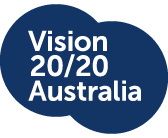Eye disorders are one of the most common long-term health problems experienced by Australian children. Good vision is critical to childhood development and education. Therefore, early detection of visual problems, and appropriate and timely treatment of eye conditions is important for all Australian children to help prevent life-long vision loss.
There is broad agreement across the eye health sector that pre-school vision screening is necessary to help detect visual problems and prevent life-long vision loss in children. Vision screening programs in Australia vary widely across the states and territories and could benefit immensely from a National Framework for children’s vision screening.
This document outlines a National Framework for Vision Screening for 3.5-5-year-olds. This age range represents an important opportunity as vision can be screened reliably, and identification and treatment of visual problems occurs prior to the commencement of school. The Framework draws on available evidence from local screening programs and protocols such as the New South Wales Statewide Eyesight Preschool Screening Program (StEPS).Its development has involved extensive consultation with sector experts, including clinicians and a range of organisations involved in eye health. Vision 2020 Australia gratefully acknowledges the sector’s contribution, insight, and advice in developing this Framework.
The National Framework’s main objective is to help facilitate universal access to integrated people-centred eye care for Australian children. This objective is in line with the World Health Assembly’s 2020 resolution on eye health and the United Nations resolution of ‘Vision for Everyone: accelerating action to achieve the Sustainable Development Goals’.
There are three core concepts that underpin this Framework. Firstly, that children between 3.5-5-years-old represent an age young enough for the visual system to be amenable to the treatment of significant visual conditions such as amblyopia, strabismus and refractive errors. Secondly, that existing screening systems should be leveraged, and the screening workforce should be flexible and broad to maximise access. Finally, post-screening follow up measures must be embedded in all vision screening programs, as this helps to ensure that children in need of treatment and/or monitoring receive appropriate and timely intervention.
The Framework comprises two sections:
- National Minimum Standard for Vision Screening for 3.5-5-year-olds
An outline of the minimum considerations/inclusions for an effective vision screening program for Australian children.
- Post-Screening Follow Up Processes
An outline of the key considerations and processes that are integral to follow-up care, screening program monitoring and evaluation.
